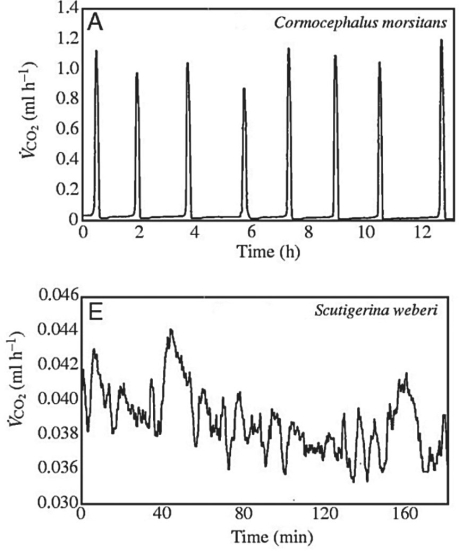Multiple Choice
Use the following information when answering the corresponding questions) .
Many terrestrial arthropods exchange gases with their environments by using tracheae, tubes that lead from openings called spiracles) in the animal's exoskeleton or cuticle directly to the animal's tissues. Some arthropods can control whether their spir opened or closed; opening the spiracles allows the carbon dioxide produced in the tissues to travel down the tracheae and be released outside the animal. Klok et al. measured the carbon dioxide emitted over time represented by VCO2) by several species of centipedes. Figure 31.2 presents graphs of their results for two species, Cormocephalus morsitans and Scutigerina weberi. C. J. Klok, R. D. Mercer, and S. L. Chown. 2002. Discontinuous gas- exchange in centipedes and its convergent evolution in tracheated arthropods.  Figure 31.2
Figure 31.2
-Look at the graph for Cormocephalus morsitans. What is the best interpretation of these results?
A) The centipede had its spiracles closed the entire time.
B) The centipede had its spiracles open the entire time.
C) The centipede had its spiracles open when CO2 emission peaked and closed when CO2 emission was low.
D) The centipede had its spiracles closed when CO2 emission peaked and open when CO2 emission was low.
Correct Answer:

Verified
Correct Answer:
Verified
Q16: <img src="https://d2lvgg3v3hfg70.cloudfront.net/TB6548/.jpg" alt=" Figure 31.1 -Refer
Q17: Which of the following attributes is not
Q18: To which of the following terrestrial habitats
Q19: Which one of these mollusc groups can
Q20: When considering the wormlike phyla within the
Q22: In arthropods, the hemocoel performs which of
Q23: The presence of a lophophore in a
Q24: What is the only group of Mollusca
Q25: If you wanted to identify an unfamiliar
Q26: Which one of these groups does not